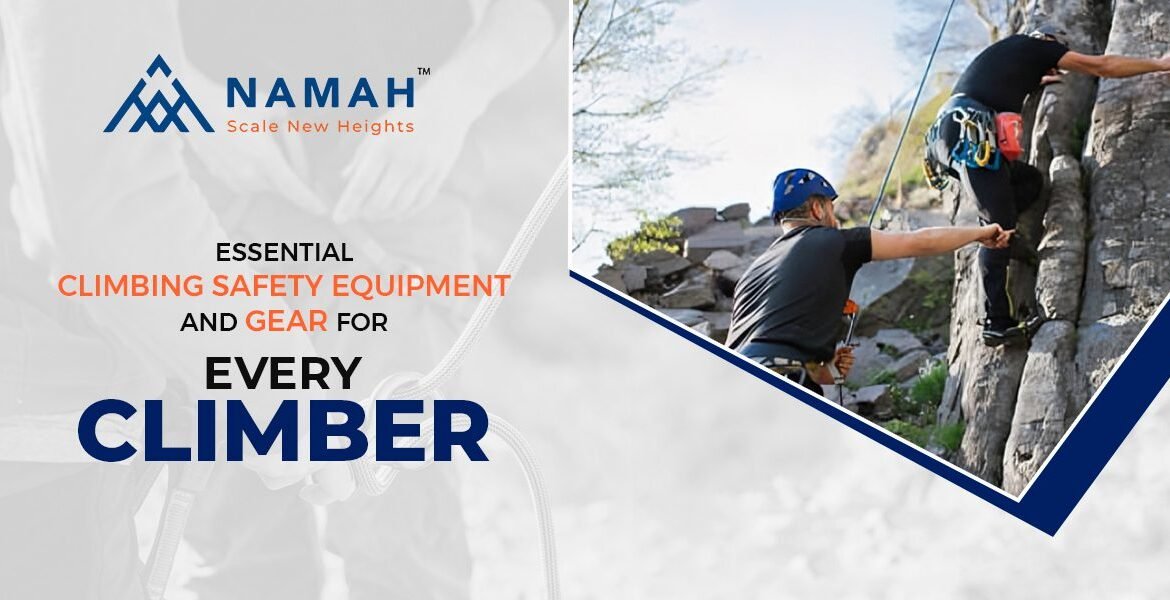Introduction to Climbing Safety Equipment
Climbing, whether for sport, recreation, or professional pursuits, demands not only skill and physical prowess but also the utmost attention to safety. The right equipment can make the difference between a successful climb and a dangerous situation. Let us explore the essential safety equipment and gear every climber should have, focusing on the latest innovations, standards, and best practices in climbing safety.
The Vital Role of Climbing Helmets
A climbing helmet is the first line of defense against head injuries, which can occur from falls or from falling objects such as rocks and equipment. Modern climbing helmets are lightweight yet durable, designed to offer maximum protection while providing comfort and ventilation.
They come in various styles and materials, each suited for different climbing environments. It’s crucial for climbers to choose helmets that meet or exceed industry safety standards, such as those set by the UIAA (International Climbing and Mountaineering Federation) and CE (Conformité Européenne).
Selecting the Right Helmet
When choosing a climbing helmet, consider factors such as weight, ventilation, fit, and compatibility with other gear like headlamps and goggles. The helmet should fit snugly without being too tight, and it should stay stable on the head, even during vigorous movement. Advanced materials like polycarbonate shells and EPS (expanded polystyrene) liners are commonly used for their ability to absorb impact and distribute force evenly.
Harnesses: Ensuring Security and Comfort on the Climb
A climbing harness is another critical piece of safety equipment, serving as the attachment point for the rope system that secures climbers to their lifeline. Harnesses must be robust, reliable, and comfortable, as climbers often wear them for extended periods.
Types of Climbing Harnesses
Harness designs vary depending on the type of climbing. For instance, sport climbing harnesses are generally lighter and more streamlined, allowing for greater mobility, while big wall harnesses are heavier but have more padding and gear loops for long ascents. Key features to consider include the number of gear loops, the strength of the load-bearing loops, and the ease of adjusting the harness while wearing gloves.
Harness Fit and Safety Checks
Proper fit is essential for safety and comfort. A harness should sit above the hips and should not slip down or twist. Regular safety checks are crucial to ensure that there are no frays, tears, or compromised buckles that could affect the integrity of the harness. It is recommended to follow the manufacturer’s guidelines for maintenance and to replace any harness that shows signs of significant wear or after a major fall.
Carabiners and Belay Devices: Core Components of Climbing Safety
Understanding Carabiners: The Versatile Connectors
Carabiners are vital in climbing for making quick and secure connections between the rope, harness, and anchor points. Their reliability is crucial for the safety of climbers, which is why understanding the different types and their specific uses is essential.
Types of Carabiners
Carabiners come in various shapes, including D-shaped, oval, and asymmetrical designs, each offering different benefits in terms of load distribution and ease of use. Materials like aluminum and steel are commonly used, with aluminium being lighter for sport climbing and steel offering greater durability for industrial applications.
Locking Mechanisms
Safety in climbing often hinges on the locking mechanism of a carabiner. Screw-lock and auto-locking carabiners are popular choices, providing an extra layer of security to prevent accidental openings. Each type has its specific application, with auto-locking carabiners being particularly valued in situations where quick and frequent connections are necessary.
The Role of Belay Devices in Climbing Safety
Belay devices are critical for managing the rope during climbing and providing control during ascents and descents. They serve as the braking system on the rope, allowing belayers to hold, release, or lower a climber safely.
Choosing the Right Belay Device
The choice of belay device can affect the safety and efficiency of climbing operations. Devices range from simple tubular devices to more sophisticated assisted-braking models that can help prevent falls by automatically locking the rope.
Innovations in Belay Technology
Recent advancements include devices that are lighter and more intuitive to use, enhancing safety without compromising performance. These innovations are particularly important in dynamic climbing situations where quick reaction times are crucial.
Climbing Ropes: The Lifeline of Every Climber
Essential Characteristics of Climbing Ropes
Climbing ropes are often considered the most critical piece of equipment for climbers, acting as the ultimate safeguard against falls. Understanding the different types of climbing ropes and their specific uses is crucial for every climber’s safety.
Types of Climbing Ropes
Climbing ropes are categorized mainly into dynamic and static ropes. Dynamic ropes are designed to stretch under load, absorbing the energy of a fall, while static ropes are used where minimal stretch is needed, such as in rappelling and rescue operations. The choice between these ropes depends on the nature of the climb and the specific requirements of the climber.
Dynamic Rope Features
Dynamic ropes are further divided into single, half, and twin ropes. Each type has its application, with single ropes being the most common for sport climbing due to their versatility and ease of use. The elongation and impact force ratings of these ropes are key factors climbers must consider to match the rope to their climbing style and the terrain.
The Importance of Rope Maintenance
Maintaining climbing ropes is essential for ensuring their longevity and reliability. Regular checks for wear, cuts, and abrasions, as well as proper storage and cleaning, are vital practices that climbers must adhere to. Techniques for proper rope care include using rope bags to avoid dirt and direct sunlight exposure, which can degrade the material over time.
Best Practices for Rope Safety
Regular inspection of ropes before and after each climb can prevent accidents. Climbers should be trained to recognize the signs of rope deterioration, such as fuzzy areas, stiff sections, or visible core threads. These indicators can suggest that the rope may no longer be safe for use and should be replaced.
Additional Essential Climbing Safety Gear
Comprehensive Safety Equipment for Climbers
While ropes, helmets, and harnesses form the core of climbing safety equipment, there are additional items that are equally crucial for a safe climbing experience. Here we cover essential safety gear, such as carabiners, climbing shoes, and protective clothing, emphasizing their importance in enhancing safety and comfort during climbs.
Protective Clothing and Climbing Shoes
Appropriate clothing is vital for protecting climbers from the elements and the rough surfaces they encounter. Specialized climbing shoes, designed for grip and comfort, play a critical role in ensuring safe and effective movement on rock faces. These shoes should offer a balance of sensitivity and support, allowing climbers to feel the rock while providing enough cushioning to absorb impact.
The Role of Personal Protective Equipment
In addition to clothing and shoes, personal protective equipment such as gloves and padded jackets can prevent injuries from rope burns or scrapes against rock surfaces. Climbing gloves, in particular, are essential for long belays and rappelling, protecting the hands while providing the necessary grip on the rope.
Climbing Technology and Safety Innovations
Advancements in climbing technology continue to improve the safety and efficiency of the sport. Devices like mobile apps for route planning and emergency communication tools are becoming increasingly popular, offering climbers additional layers of safety.
Technological Aids in Climbing Safety
GPS devices and mobile apps can help climbers navigate difficult terrains and keep track of their routes. Emergency communication tools, such as satellite phones and PLBs (Personal Locator Beacons), are crucial for alerting rescue services in case of an accident, especially in remote areas where regular mobile service is unavailable.
Namah Ropes is a leading manufacturer specializing in high-quality ropes, harnesses, and slings, known for its commitment to safety, innovation, and durability. The company utilizes advanced materials and state-of-the-art manufacturing processes to meet the stringent demands of diverse industries, ensuring its products offer superior performance and reliability. Namah Ropes places a strong emphasis on customer satisfaction and environmental sustainability in its operations.




